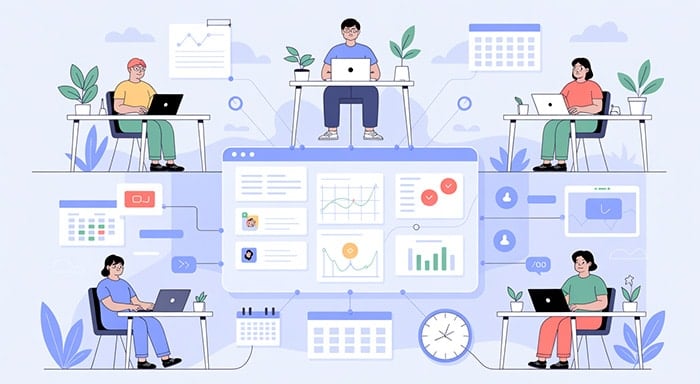As worldwide organizations are transitioning to remote work, productivity management has become a topmost requirement for companies. In remote work, employees collaborate from numerous locations, and it can be tough for managers to make sure that the teams remain focused and committed to deadlines. Employee monitoring software ensures a robust solution to this challenge. These platforms give managers in-depth insights into employee performance, fostering productivity tracking and robust decision-making. When it is implemented well, it can drive growth in both team and individual performance. This fosters a collaborative and productive environment for remote working.
Enhancing Focus and Time Management
Employee monitoring tools help remote teams by offering detailed insights into how time is being spent throughout the day. Rather than relying on employees to self-report their productivity, these tools provide an objective view of where time is being allocated. This can be valuable in recognizing areas where employees might be spending too much effort on non-productive aspects or getting distracted by other work.
For example, these platforms can monitor the time employees spend on applications, projects, or websites. If an employee spends a substantial amount of time on unofficial websites, it empowers them to address issues early on, allowing employees to refocus. In addition, tracking platforms can provide data on patterns of work, enabling managers to figure out areas of inefficiencies and recommend changes that can lead to more effective utilization of time.
By monitoring working hours and making sure that the time is wisely spent, employee tracking platforms help employees to stay focused on tasks, ensuring great time management across all areas.
Enhanced Transparency and Accountability
One of the main advantages of employee tracking platforms is the accountability it encourages. When employees know their activities are being tracked, they tend to remain focused on the task and work hard to meet the deadlines. These platforms aid in creating strong connection between outcomes and effort, which can allow employees to remain diligent and concentrated on work.
In the teams that work remotely, managers cannot ensure direct oversight of the employees. In such situations, such platforms play a vital role in ensuring greater visibility into work progress. Instead of depending on check-ins or reports, tracking platforms render real-time updates on tasks, project status, or completed projects. Teams often use platforms like Nectar to centralize these updates and measure engagement so managers and employees stay aligned. This creates a more transparent work environment where managers and employees have similar metrics to focus on. This will further minimize the possibilities of miscommunication, missed deadlines, or protracted projects.
Key Advantages of Employee Tracking Platforms
- Enhanced Management of Time: Tracking platforms allow employees to remain focused on monitoring the time spent on core tasks, enabling managers to recognize inefficiencies.
- Enhanced Accountability: Monitoring of work in real-time allows employees to remain accountable and ensures total commitment toward project objectives.
Ensuring Feedback and Consistent Enhancement
Employee monitoring solutions deliver value well beyond productivity tracking. When integrated with 360-degree feedback software, they create a comprehensive system for constructive development. Managers can get an overview of the information rendered by the platforms to recognize areas where employees might need training or support. For instance, if a team member is struggling continuously with the management of time, the data provided by the tool can act as a discussion point to provide guidance or recommend enhancements. The pattern recognition capabilities also help leaders acknowledge top performers, essential for maintaining morale and encouraging continued excellence across teams.
Moreover, the ability to gain an overview of patterns enables managers to recognize and appreciate success. It helps in acknowledging employees who are performing well continuously. Positive feedback is vital for employee morale and help teams to carry on their efficient work.
Right Practices for Deploying Employee Tracking Platforms
- Transparency: Always inform employees about the tools being used and the purpose behind monitoring their activities.
- Balance: Avoid overly intrusive monitoring methods like keystroke tracking or excessive screenshots, which can negatively impact trust.
Fostering a Healthy Environment for Work
Another way employee tracking platforms raise overall productivity is through allowing management to figure out early signs of overwork or burnout. Since remote work can sometimes mix up both professional and personal life, it becomes easy for the employees to overexert themselves. Tracking platforms that monitor task progress and work hours can allow managers to identify when an employee is overworking or struggling to manage their workload. In such situations, managers can often intervene by providing more support, adjusting workloads, or motivating employees to take required breaks.
Conclusion
Employee tracking platforms, when utilized transparently and thoughtfully, can significantly improve productivity of the remote teams. By enhancing time management, nurturing accountability, and providing insights into patterns of work, such platforms help remote teams to remain aligned, focused, or efficient. However, it is vital to utilize these platforms in a way that boosts trust and communication. With the best approach, monitoring platforms can become a great resource for both managers and employees, enhancing productivity while ensuring a positive environment for work.
Related Post:
Integrating Employee Performance with CRM Systems for Business Success



